technical specifications Lancia Musa 2009 Owner handbook (in English)
[x] Cancel search | Manufacturer: LANCIA, Model Year: 2009, Model line: Musa, Model: Lancia Musa 2009Pages: 218, PDF Size: 3.7 MB
Page 118 of 218

117
WARNING
LIGHTS AND
MESSAGES
IN AN
EMERGENCY
MAINTENANCE
AND CARE
TECHNICALSPECIFICATIONS
INDEX
DASHBOARD
AND CONTROLS
SAFETY
DEVICES
STARTING
AND
DRIVING
USING THE
MECHANICAL
GEARBOX
To engage the gears, press the clutch
pedal fully and shift the gear lever
into one of the required positions (the
diagram is shown on the knob).
IMPORTANT Reverse may only be
engaged when the car is at a stand-
still. With the engine running, wait for
at least 2 seconds with the clutch
pedal fully pressed before engaging
reverse to prevent damage to the gears
and grating.
To engage sixth gear (where pro-
vided), operate the lever by pressing
it towards the right in order to avoid
engaging fourth gear by mistake. The
same applies when shifting from sixth
to fifth gear.
To engage reverse Rfrom neutral, lift
the sliding collar A-fig. 2-3 under the
knob while shifting the lever towards
the right and then backwards (only
for petrol versions).
For Multijet versions, only shift the
lever towards the right and then back-
wards.
fig. 2L0D0150m
fig. 3L0D0360m
Do not drive with the hand
resting on the gear lever, be-
cause this pressure, even if
light, over time can wear
gear inner components.
Press the clutch pedal fully
to change gears correctly.
For this reason, there must be no
obstacles on the floor under the ped-
als: ensure that rubber mats (if any)
are correctly positioned, not inter-
fering with the pedals.
WARNING
113-124 MUSA 1ed GB 10-07-2008 9:37 Pagina 117
Page 119 of 218
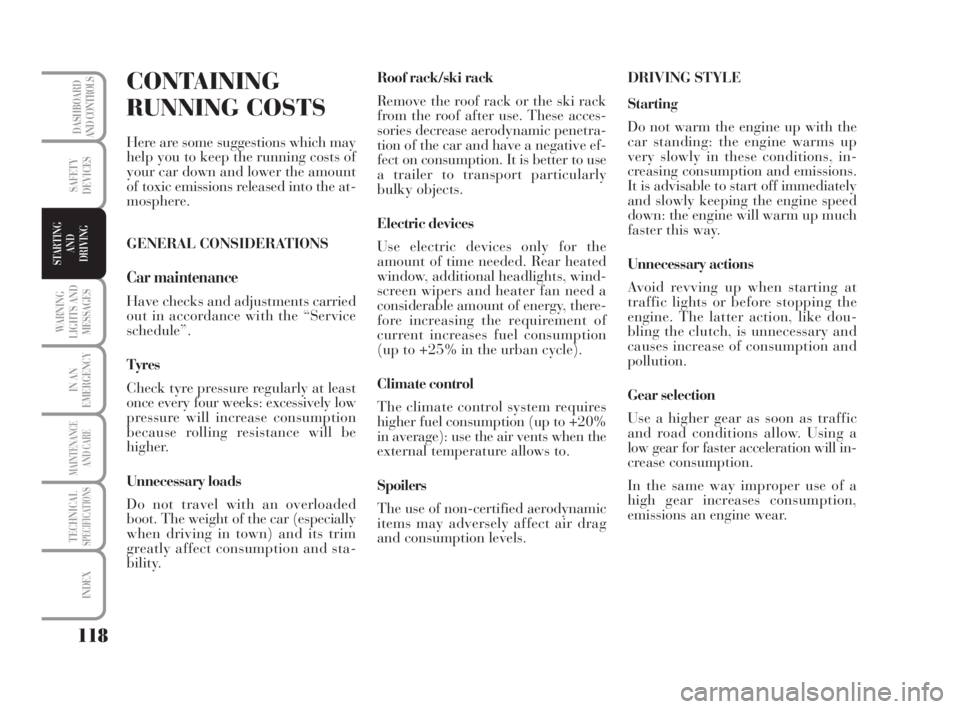
118
WARNING
LIGHTS AND
MESSAGES
IN AN
EMERGENCY
MAINTENANCE
AND CARE
TECHNICALSPECIFICATIONS
INDEX
DASHBOARD
AND CONTROLS
SAFETY
DEVICES
STARTING
AND
DRIVING
CONTAINING
RUNNING COSTS
Here are some suggestions which may
help you to keep the running costs of
your car down and lower the amount
of toxic emissions released into the at-
mosphere.
GENERAL CONSIDERATIONS
Car maintenance
Have checks and adjustments carried
out in accordance with the “Service
schedule”.
Tyres
Check tyre pressure regularly at least
once every four weeks: excessively low
pressure will increase consumption
because rolling resistance will be
higher.
Unnecessary loads
Do not travel with an overloaded
boot. The weight of the car (especially
when driving in town) and its trim
greatly affect consumption and sta-
bility.Roof rack/ski rack
Remove the roof rack or the ski rack
from the roof after use. These acces-
sories decrease aerodynamic penetra-
tion of the car and have a negative ef-
fect on consumption. It is better to use
a trailer to transport particularly
bulky objects.
Electric devices
Use electric devices only for the
amount of time needed. Rear heated
window, additional headlights, wind-
screen wipers and heater fan need a
considerable amount of energy, there-
fore increasing the requirement of
current increases fuel consumption
(up to +25% in the urban cycle).
Climate control
The climate control system requires
higher fuel consumption (up to +20%
in average): use the air vents when the
external temperature allows to.
Spoilers
The use of non-certified aerodynamic
items may adversely affect air drag
and consumption levels.DRIVING STYLE
Starting
Do not warm the engine up with the
car standing: the engine warms up
very slowly in these conditions, in-
creasing consumption and emissions.
It is advisable to start off immediately
and slowly keeping the engine speed
down: the engine will warm up much
faster this way.
Unnecessary actions
Avoid revving up when starting at
traffic lights or before stopping the
engine. The latter action, like dou-
bling the clutch, is unnecessary and
causes increase of consumption and
pollution.
Gear selection
Use a higher gear as soon as traffic
and road conditions allow. Using a
low gear for faster acceleration will in-
crease consumption.
In the same way improper use of a
high gear increases consumption,
emissions an engine wear.
113-124 MUSA 1ed GB 10-07-2008 9:37 Pagina 118
Page 120 of 218
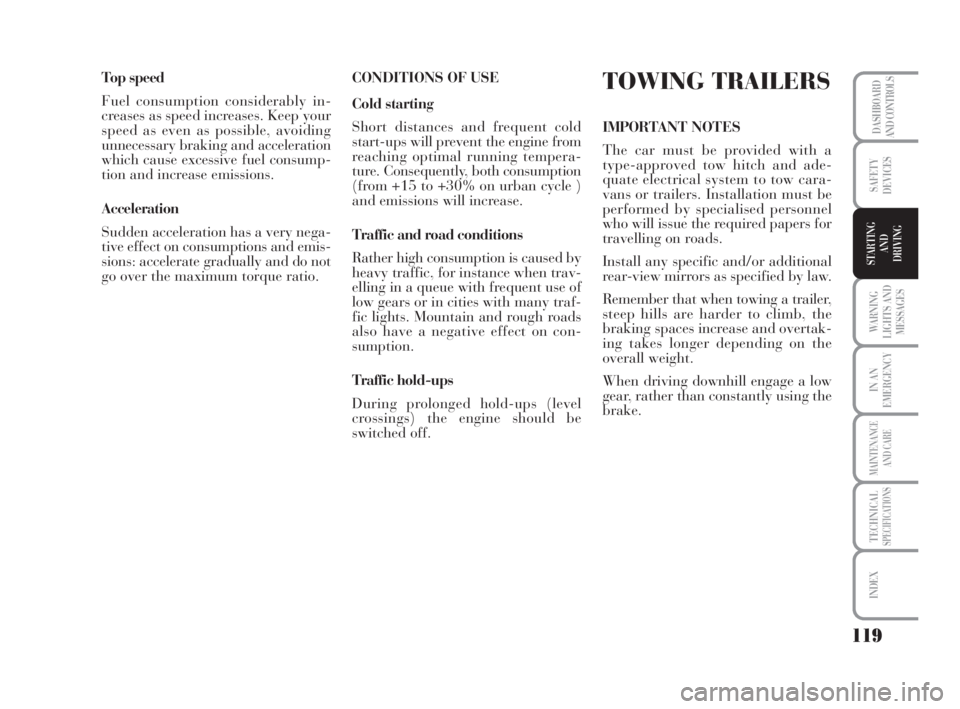
119
WARNING
LIGHTS AND
MESSAGES
IN AN
EMERGENCY
MAINTENANCE
AND CARE
TECHNICALSPECIFICATIONS
INDEX
DASHBOARD
AND CONTROLS
SAFETY
DEVICES
STARTING
AND
DRIVING
Top speed
Fuel consumption considerably in-
creases as speed increases. Keep your
speed as even as possible, avoiding
unnecessary braking and acceleration
which cause excessive fuel consump-
tion and increase emissions.
Acceleration
Sudden acceleration has a very nega-
tive effect on consumptions and emis-
sions: accelerate gradually and do not
go over the maximum torque ratio.CONDITIONS OF USE
Cold starting
Short distances and frequent cold
start-ups will prevent the engine from
reaching optimal running tempera-
ture. Consequently, both consumption
(from +15 to +30% on urban cycle )
and emissions will increase.
Traffic and road conditions
Rather high consumption is caused by
heavy traffic, for instance when trav-
elling in a queue with frequent use of
low gears or in cities with many traf-
fic lights. Mountain and rough roads
also have a negative effect on con-
sumption.
Traffic hold-ups
During prolonged hold-ups (level
crossings) the engine should be
switched off.TOWING TRAILERS
IMPORTANT NOTES
The car must be provided with a
type-approved tow hitch and ade-
quate electrical system to tow cara-
vans or trailers. Installation must be
performed by specialised personnel
who will issue the required papers for
travelling on roads.
Install any specific and/or additional
rear-view mirrors as specified by law.
Remember that when towing a trailer,
steep hills are harder to climb, the
braking spaces increase and overtak-
ing takes longer depending on the
overall weight.
When driving downhill engage a low
gear, rather than constantly using the
brake.
113-124 MUSA 1ed GB 10-07-2008 9:37 Pagina 119
Page 121 of 218
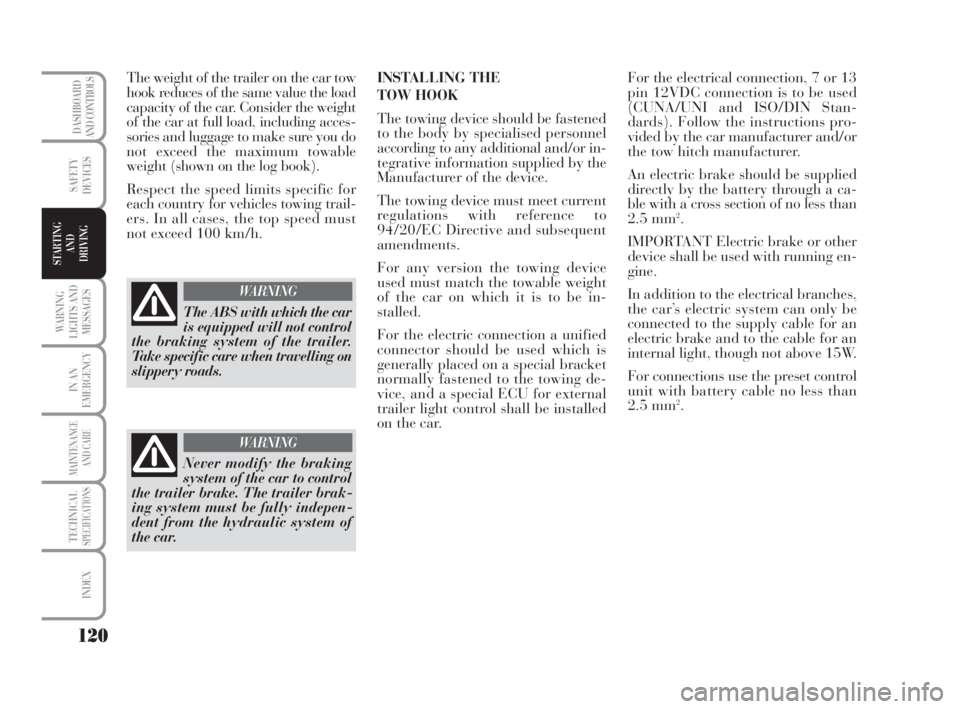
120
WARNING
LIGHTS AND
MESSAGES
IN AN
EMERGENCY
MAINTENANCE
AND CARE
TECHNICALSPECIFICATIONS
INDEX
DASHBOARD
AND CONTROLS
SAFETY
DEVICES
STARTING
AND
DRIVING
The weight of the trailer on the car tow
hook reduces of the same value the load
capacity of the car. Consider the weight
of the car at full load, including acces-
sories and luggage to make sure you do
not exceed the maximum towable
weight (shown on the log book).
Respect the speed limits specific for
each country for vehicles towing trail-
ers. In all cases, the top speed must
not exceed 100 km/h.
The ABS with which the car
is equipped will not control
the braking system of the trailer.
Take specific care when travelling on
slippery roads.
WARNING
Never modify the braking
system of the car to control
the trailer brake. The trailer brak-
ing system must be fully indepen-
dent from the hydraulic system of
the car.
WARNING
INSTALLING THE
TOW HOOK
The towing device should be fastened
to the body by specialised personnel
according to any additional and/or in-
tegrative information supplied by the
Manufacturer of the device.
The towing device must meet current
regulations with reference to
94/20/EC Directive and subsequent
amendments.
For any version the towing device
used must match the towable weight
of the car on which it is to be in-
stalled.
For the electric connection a unified
connector should be used which is
generally placed on a special bracket
normally fastened to the towing de-
vice, and a special ECU for external
trailer light control shall be installed
on the car. For the electrical connection, 7 or 13
pin 12VDC connection is to be used
(CUNA/UNI and ISO/DIN Stan-
dards). Follow the instructions pro-
vided by the car manufacturer and/or
the tow hitch manufacturer.
An electric brake should be supplied
directly by the battery through a ca-
ble with a cross section of no less than
2.5 mm
2.
IMPORTANT Electric brake or other
device shall be used with running en-
gine.
In addition to the electrical branches,
the car’s electric system can only be
connected to the supply cable for an
electric brake and to the cable for an
internal light, though not above 15W.
For connections use the preset control
unit with battery cable no less than
2.5 mm
2.
113-124 MUSA 1ed GB 10-07-2008 9:37 Pagina 120
Page 122 of 218

121
WARNING
LIGHTS AND
MESSAGES
IN AN
EMERGENCY
MAINTENANCE
AND CARE
TECHNICALSPECIFICATIONS
INDEX
DASHBOARD
AND CONTROLS
SAFETY
DEVICES
STARTING
AND
DRIVING
with load
Existing holes
Existing holes
fig. 4
ASSEMBLY DIAGRAM fig. 4
The tow hook structure must be fastened in the points
shown by the symbol
Øusing a total of 4 M8, 2 M10 and
2 M12 screws.
The hook should be fastened to the body avoiding any
type of drilling and trimming of the rear bumpers that re-
mains visible when the hook is removed.
IMPORTANT It is compulsory to fasten a label (plainly
visible) of suitable size and material with the following
wording:
MAX LOAD ON BALL 60 kg
After fitting, screw holes shall be sealed to pre-
vent exhaust gas inlet.
WARNING
L0D0256m
> 318 ± 5
Standard trow ball
113-124 MUSA 1ed GB 10-07-2008 9:37 Pagina 121
Page 123 of 218
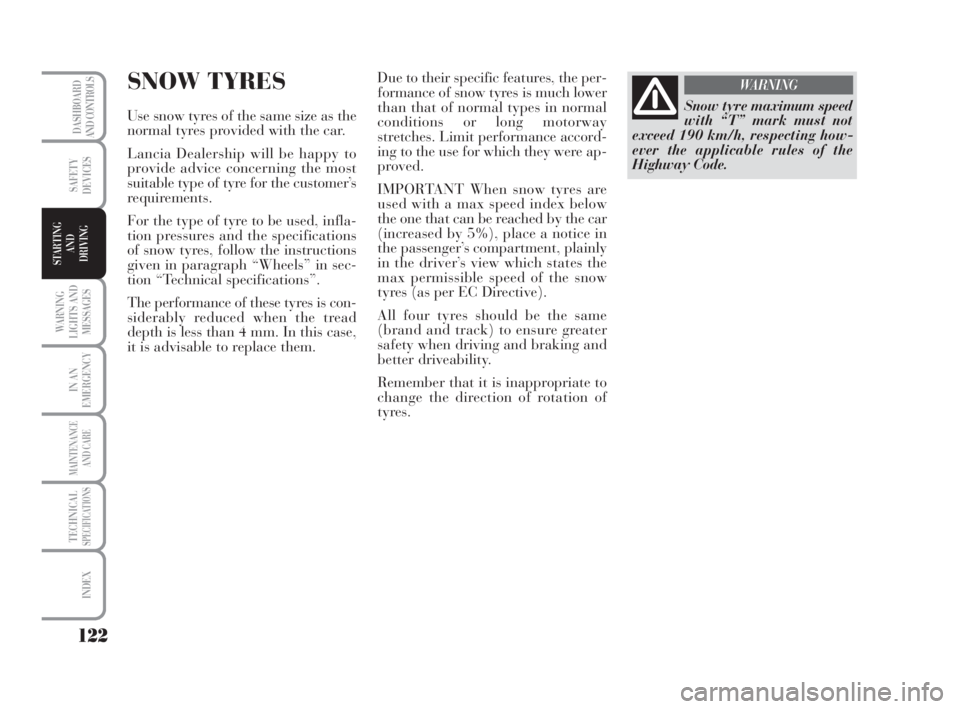
122
WARNING
LIGHTS AND
MESSAGES
IN AN
EMERGENCY
MAINTENANCE
AND CARE
TECHNICALSPECIFICATIONS
INDEX
DASHBOARD
AND CONTROLS
SAFETY
DEVICES
STARTING
AND
DRIVING
SNOW TYRES
Use snow tyres of the same size as the
normal tyres provided with the car.
Lancia Dealership will be happy to
provide advice concerning the most
suitable type of tyre for the customer’s
requirements.
For the type of tyre to be used, infla-
tion pressures and the specifications
of snow tyres, follow the instructions
given in paragraph “Wheels” in sec-
tion “Technical specifications”.
The performance of these tyres is con-
siderably reduced when the tread
depth is less than 4 mm. In this case,
it is advisable to replace them.Due to their specific features, the per-
formance of snow tyres is much lower
than that of normal types in normal
conditions or long motorway
stretches. Limit performance accord-
ing to the use for which they were ap-
proved.
IMPORTANT When snow tyres are
used with a max speed index below
the one that can be reached by the car
(increased by 5%), place a notice in
the passenger’s compartment, plainly
in the driver’s view which states the
max permissible speed of the snow
tyres (as per EC Directive).
All four tyres should be the same
(brand and track) to ensure greater
safety when driving and braking and
better driveability.
Remember that it is inappropriate to
change the direction of rotation of
tyres.Snow tyre maximum speed
with “T” mark must not
exceed 190 km/h, respecting how-
ever the applicable rules of the
Highway Code.
WARNING
113-124 MUSA 1ed GB 10-07-2008 9:37 Pagina 122
Page 124 of 218
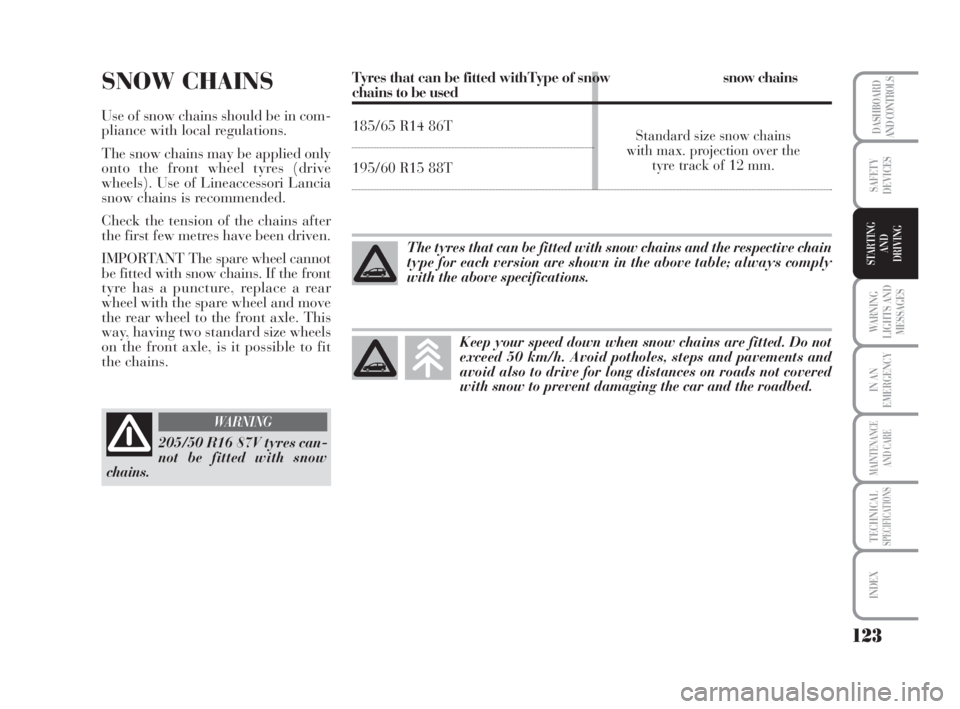
123
WARNING
LIGHTS AND
MESSAGES
IN AN
EMERGENCY
MAINTENANCE
AND CARE
TECHNICALSPECIFICATIONS
INDEX
DASHBOARD
AND CONTROLS
SAFETY
DEVICES
STARTING
AND
DRIVING
SNOW CHAINS
Use of snow chains should be in com-
pliance with local regulations.
The snow chains may be applied only
onto the front wheel tyres (drive
wheels). Use of Lineaccessori Lancia
snow chains is recommended.
Check the tension of the chains after
the first few metres have been driven.
IMPORTANT The spare wheel cannot
be fitted with snow chains. If the front
tyre has a puncture, replace a rear
wheel with the spare wheel and move
the rear wheel to the front axle. This
way, having two standard size wheels
on the front axle, is it possible to fit
the chains.
The tyres that can be fitted with snow chains and the respective chain
type for each version are shown in the above table; always comply
with the above specifications.
Keep your speed down when snow chains are fitted. Do not
exceed 50 km/h. Avoid potholes, steps and pavements and
avoid also to drive for long distances on roads not covered
with snow to prevent damaging the car and the roadbed.
Tyres that can be fitted withType of snow snow chainschains to be used
185/65 R14 86T
195/60 R15 88T
205/50 R16 87V tyres can-
not be fitted with snow
chains.
WARNING
Standard size snow chains
with max. projection over the
tyre track of 12 mm.
113-124 MUSA 1ed GB 10-07-2008 9:37 Pagina 123
Page 125 of 218
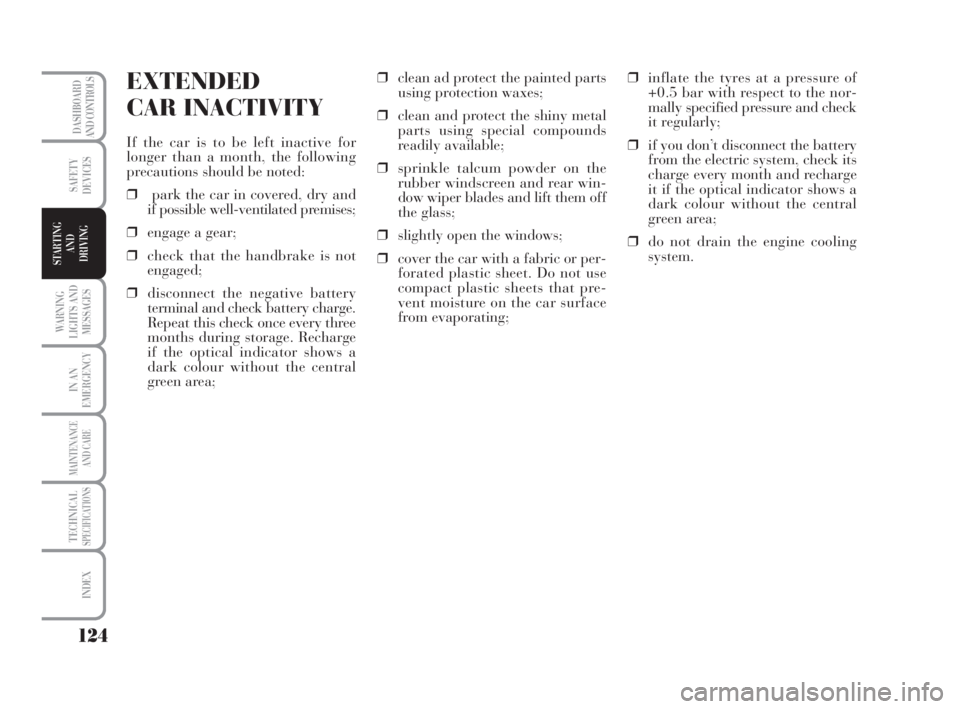
124
WARNING
LIGHTS AND
MESSAGES
IN AN
EMERGENCY
MAINTENANCE
AND CARE
TECHNICALSPECIFICATIONS
INDEX
DASHBOARD
AND CONTROLS
SAFETY
DEVICES
STARTING
AND
DRIVING
EXTENDED
CAR INACTIVITY
If the car is to be left inactive for
longer than a month, the following
precautions should be noted:
❒park the car in covered, dry and
if possible well-ventilated premises;
❒engage a gear;
❒check that the handbrake is not
engaged;
❒disconnect the negative battery
terminal and check battery charge.
Repeat this check once every three
months during storage. Recharge
if the optical indicator shows a
dark colour without the central
green area;❒clean ad protect the painted parts
using protection waxes;
❒clean and protect the shiny metal
parts using special compounds
readily available;
❒sprinkle talcum powder on the
rubber windscreen and rear win-
dow wiper blades and lift them off
the glass;
❒slightly open the windows;
❒cover the car with a fabric or per-
forated plastic sheet. Do not use
compact plastic sheets that pre-
vent moisture on the car surface
from evaporating;❒inflate the tyres at a pressure of
+0.5 bar with respect to the nor-
mally specified pressure and check
it regularly;
❒if you don’t disconnect the battery
from the electric system, check its
charge every month and recharge
it if the optical indicator shows a
dark colour without the central
green area;
❒do not drain the engine cooling
system.
113-124 MUSA 1ed GB 10-07-2008 9:37 Pagina 124
Page 126 of 218
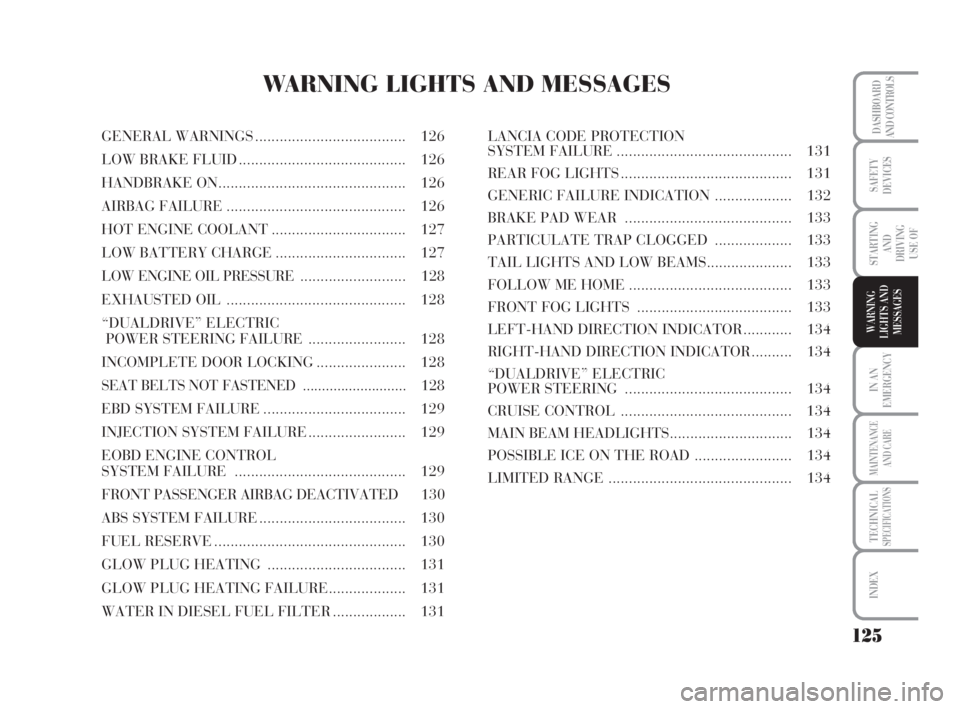
125
IN AN
EMERGENCY
MAINTENANCE
AND CARE
TECHNICALSPECIFICATIONS
INDEX
DASHBOARD
AND CONTROLS
SAFETY
DEVICES
STARTING
AND
DRIVING
USE OF
THE CAR
WARNING
LIGHTS AND
MESSAGES
WARNING LIGHTS AND MESSAGES
GENERAL WARNINGS..................................... 126
LOW BRAKE FLUID......................................... 126
HANDBRAKE ON.............................................. 126
AIRBAG FAILURE............................................ 126
HOT ENGINE COOLANT................................. 127
LOW BATTERY CHARGE................................ 127
LOW ENGINE OIL PRESSURE .......................... 128
EXHAUSTED OIL ............................................ 128
“DUALDRIVE” ELECTRIC
POWER STEERING FAILURE ........................ 128
INCOMPLETE DOOR LOCKING...................... 128
SEAT BELTS NOT FASTENED ........................... 128
EBD SYSTEM FAILURE................................... 129
INJECTION SYSTEM FAILURE........................ 129
EOBD ENGINE CONTROL
SYSTEM FAILURE .......................................... 129
FRONT PASSENGER AIRBAG DEACTIVATED 130
ABS SYSTEM FAILURE.................................... 130
FUEL RESERVE............................................... 130
GLOW PLUG HEATING.................................. 131
GLOW PLUG HEATING FAILURE................... 131
WATER IN DIESEL FUEL FILTER.................. 131LANCIA CODE PROTECTION
SYSTEM FAILURE........................................... 131
REAR FOG LIGHTS.......................................... 131
GENERIC FAILURE INDICATION ................... 132
BRAKE PAD WEAR ......................................... 133
PARTICULATE TRAP CLOGGED ................... 133
TAIL LIGHTS AND LOW BEAMS..................... 133
FOLLOW ME HOME........................................ 133
FRONT FOG LIGHTS ...................................... 133
LEFT-HAND DIRECTION INDICATOR............ 134
RIGHT-HAND DIRECTION INDICATOR.......... 134
“DUALDRIVE” ELECTRIC
POWER STEERING ......................................... 134
CRUISE CONTROL .......................................... 134
MAIN BEAM HEADLIGHTS.............................. 134
POSSIBLE ICE ON THE ROAD ........................ 134
LIMITED RANGE ............................................. 134
125-134 MUSA 1ed GB 10-07-2008 9:38 Pagina 125
Page 127 of 218
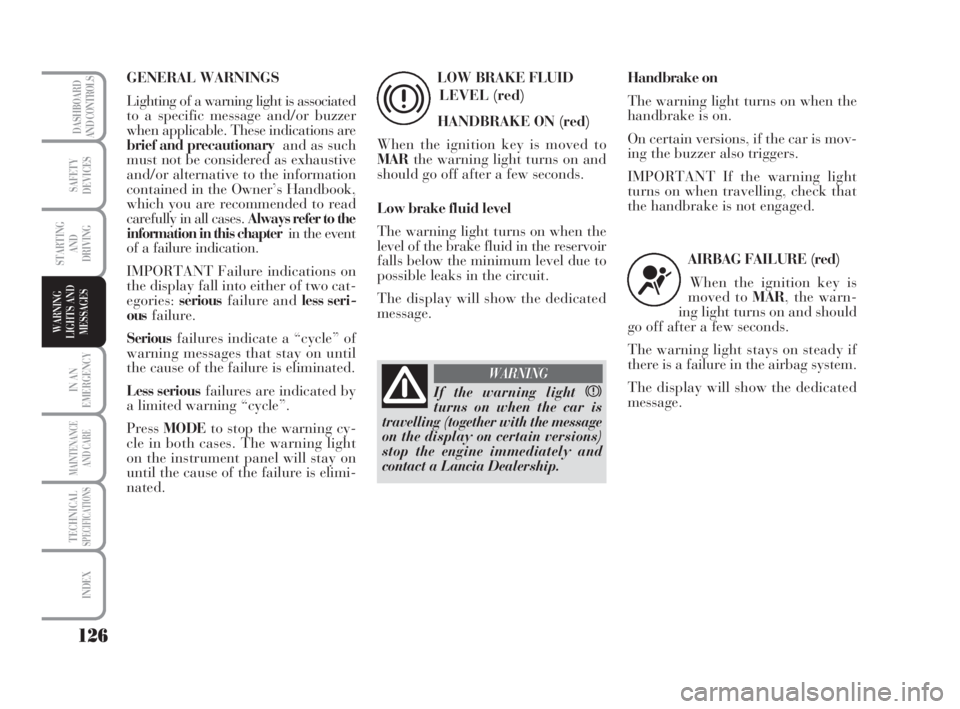
126
IN AN
EMERGENCY
MAINTENANCE
AND CARE
TECHNICALSPECIFICATIONS
INDEX
DASHBOARD
AND CONTROLS
SAFETY
DEVICES
STARTING
AND
DRIVING
WARNING
LIGHTS AND
MESSAGES
GENERAL WARNINGS
Lighting of a warning light is associated
to a specific message and/or buzzer
when applicable. These indications are
brief and precautionary and as such
must not be considered as exhaustive
and/or alternative to the information
contained in the Owner’s Handbook,
which you are recommended to read
carefully in all cases. Always refer to the
information in this chapter in the event
of a failure indication.
IMPORTANT Failure indications on
the display fall into either of two cat-
egories:seriousfailure and less seri -
ousfailure.
Seriousfailures indicate a “cycle” of
warning messages that stay on until
the cause of the failure is eliminated.
Less seriousfailures are indicated by
a limited warning “cycle”.
PressMODEto stop the warning cy-
cle in both cases. The warning light
on the instrument panel will stay on
until the cause of the failure is elimi-
nated.LOW BRAKE FLUID
LEVEL (red)
HANDBRAKE ON (red)
When the ignition key is moved to
MARthe warning light turns on and
should go off after a few seconds.
Low brake fluid level
The warning light turns on when the
level of the brake fluid in the reservoir
falls below the minimum level due to
possible leaks in the circuit.
The display will show the dedicated
message.
x
Handbrake on
The warning light turns on when the
handbrake is on.
On certain versions, if the car is mov-
ing the buzzer also triggers.
IMPORTANT If the warning light
turns on when travelling, check that
the handbrake is not engaged.
AIRBAG FAILURE (red)
When the ignition key is
moved to MAR, the warn-
ing light turns on and should
go off after a few seconds.
The warning light stays on steady if
there is a failure in the airbag system.
The display will show the dedicated
message.
¬
If the warning light x
turns on when the car is
travelling (together with the message
on the display on certain versions)
stop the engine immediately and
contact a Lancia Dealership.
WARNING
125-134 MUSA 1ed GB 10-07-2008 9:38 Pagina 126